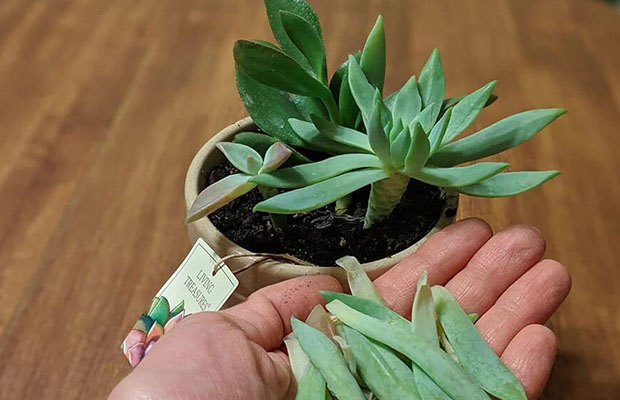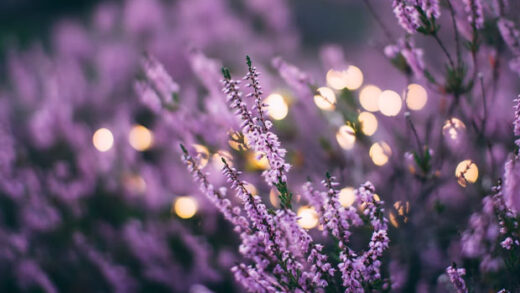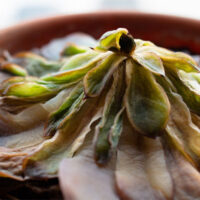The fleshy-leaved plants that go by the name “succulent” respond to a variety of environmental stresses by stopping their growth and losing their leaves in order to conserve energy. Succulents’ leaves can fall off abruptly due to chemical stress, improper watering, extreme temperatures, extreme light levels, and extreme light intensity.
Despite being typically simple to maintain, succulents are not completely unbreakable. So, if you’re new to the succulent world, it can be discouraging if your plant doesn’t thrive. Do you know why are succulent leaves falling off?
The health of plants is influenced by a wide range of variables. Your plant’s health can be influenced by water, sunlight, temperature, soil, and even the container you’ve used to grow it.
Keep reading and learn why and how to do with succulent leaves falling off.
Table of Contents
Causes For Leaves Falling Off Succulents
1. A Need For Reduction In Energy Needs
Symptom: Lower Succulent Leaves Turning Brown And Crispy
When leaves start to fall off of succulents, people frequently become alarmed, especially if they don’t have much prior experience with succulents. But did you know that as houseplants grow, they typically lose their bottom leaves on their own?
Since they are now obscured by larger leaves near the plant’s top, those leaves are no longer useful. Actually, there is no cause for concern if it only occasionally loses bottom leaves.
What To Do:
It is a normal occurrence for a plant to try to absorb as much energy from its leaves as it can before letting them go. You can either wait until they fall naturally or, if you find the browned leaves unsightly, just carefully remove them.
2. Too Much Water
Symptom: Succulent Leaves Turning Soft, Translucent And Yellowish
This is confusing because a succulent leaf that has been submerged in water can also feel a little floppy and soft. However, the yellowing of the leaves and the presence of root rot when you remove the plant from its pot are definite giveaways.
Although they will weaken and wilt if you water them too little, succulents are known for having low water requirements, so you must be careful not to overwater them. When succulents are watered excessively or frequently, their leaves can swell and eventually fall off the plant. Waiting until the soil is nearly dry and the leaves appear slightly wrinkled is the proper time to water succulents. Once you see the extra water draining from the pot’s drainage holes, continue to water thoroughly. Therefore, when growing succulents, always use containers with drainage holes.
Your plant may suffer serious effects from overwatering. Succulents’ leaves may fall off as a result, and it may even completely kill the plant! When we say that overwatering is the leading reason for succulent deaths, we aren’t joking. Excess water causes the succulents’ cell walls to swell.
Succulents should only be watered when the soil they are planted in feels completely dry to the touch. Your succulents will probably require watering once every two to three weeks.
What To Do:
The overwatered succulent must have all of its impacted leaves removed. Look to see if the stem has rotted; if so, cut off the rotted portion and leave the healthy portion of the plant in a dry place for a week. During this time, stop watering the plant.
After a week, re-pot the healthy part of the plant and start a regular watering cycle. Succulents require good drainage, so it’s a good idea to plant them in a pot with drainage holes at the bottom and a grittier soil mixture (like the ones shown here).
3. Too Little Water
Symptom: Succulent Leaves Are Wrinkled And Shrunken
Even though overwatering is frequently linked to the loss of succulent leaves, underwatering will also result in the same thing. Your outdoor succulents may look weak and begin to wilt if you neglect to water them for a number of days.
The succulent that has been submerged in water will have soft, wrinkly leaves. Not much of a color change can be seen, unlike overwatered leaves. When touched, the leaves fall off immediately, and no amount of watering will make up for leaves that are too damaged to recover.
What To Do:
Unless it was severely underwatered, your succulent can usually be revived. Your succulents will quickly become happier if you simply slightly increase the frequency of your waterings.
Related Reading: How Much Water Do Succulents Need?
4. Too Little Light
Symptom: Overall Straggly Succulent, New Leaves Growing Smaller In Size
If kept in low light conditions for a long enough period of time, succulents may start to drop their leaves. The fact that succulents are naturally adapted to habitats with abundant year-round sunlight means that they require a lot of light. They prefer brightly lit areas, and if there is not enough light, they will become straggly and yellow as they attempt to reach the light source. New leaves also have a tendency to get smaller over time. They will eventually lose their leaves if the problem is not fixed.
What To Do:
Fortunately, it’s very simple to solve this problem! Just put your plant somewhere that gets more sunlight, or under a grow light like this one. For more grow lights that we recommend, check out our article here.
But be sure to acclimate your succulent first before placing it outside and subjecting it to the intense heat of the sun. Sunburns can also occur on succulents!
You should only expose your succulent to about three hours of natural or artificial light per day to acclimate it for the outdoors (avoid the afternoon sun). You run the risk of burning it if you do anything more. Then, gradually increase the amount of sun exposure over a few weeks until it receives roughly five to six hours of direct sunlight each day or about 12 hours of artificial light.
Related Reading: How Much Light Do Succulents Need?
5. Chemical Shock
Symptom: Limp, Wilted, Crinkled, Brittle, Or Very Small Leaves And Stems
The loss of leaves in a succulent can also result from shocking the plant’s system. While it may be tempting to act hastily and excessively when succulents contract fungus or other diseases, you must be cautious. Never apply more than what is advised when using any chemical; always follow the directions on the package. Prior to applying the chemicals, you should always confirm that your succulent is not already under stress from the environment.
Your succulent’s growth may be slowed down rather than accelerated if you fertilize it excessively. Additionally, your succulent’s leaves may fall off, turn other colors, and even have burned roots.
What To Do:
This leftover salt from the fertilizer can burn your plant if it is left on the soil surface if you notice any white crystals. Don’t worry; most plants that have been overfertilized can be saved with a few easy steps. Remove any fertilizer that is readily visible from the soil and plant, then let water pass through the roots to leach the fertilizer away. After that, take out any damaged foliage and give your plant another feeding after about a month.
In the future, keep in mind to only fertilize your succulent plants with a water-soluble fertilizer, such as this one from Miracle-Gro that has been diluted to half-strength. During their growth phase, you should only feed them a few times a month, no more. They won’t become nutrient-overloaded and start dropping leaves if you do this.
6. Extreme Heat
Symptom: Wilted Leaves That May Or May Not Have Turned A Shade Of Red Or Orange
The majority of succulents grow in environments that are naturally harsh, with little in the way of nearby plants to offer shade and exposure to intense sunlight. However, this does not imply that they are unbreakable.
Your succulents will suffer in the summer if they are in a sunny, enclosed space like a windowsill or patio, which can get extremely hot. This is especially problematic if the succulent is young and hasn’t yet adapted to such a hot environment.
Because the majority of succulents are native to hot, arid regions where prolonged periods of heat are common, they react to stress from drought or heat by losing leaves. While this is perfectly normal, keeping succulents in the shade as the temperature rises will help avoid it.
What To Do:
Keep an eye on them because when touched, the leaves easily fall off. If they appear wilted or sunburned, either move them or cover them with a shade cloth.

7. Extreme Cold
Symptom: Succulent Leaves Drooping And Turning Black Before Dropping
Most succulents can’t tolerate extremely cold temperatures, and if they’re exposed to subfreezing temperatures for an extended period of time, the cells inside their leaves may freeze and suffer irreparable harm.
Its leaves will appear either brown or black and somewhat mushy if your succulent has frozen over the winter. The entire plant will appear rotten if the damage from the frost is severe. It is essentially beyond repair in such a circumstance.
However, your succulent will recover if only a few leaves here and there had been harmed by the frost. Avoid removing these protective dead leaves because they may occasionally fall off but, in most cases, the plant has already produced new leaves to take their place.
What To Do:
All that is left to do at this point is attempt to control it because the damage has already been done.
Move the plant first to a more enclosed space with a small temperature difference. A good alternative to going from the outside to a warm environment inside is to go from the outside to a garage.
Keep in mind that watering needs to be completely avoided if you must keep your succulents outside during the winter. If the soil is wet, it will freeze and cause damage to the roots. When kept utterly dry, succulents have the best chance of surviving.
Roy Cohen from Hack My Garage says: “Depending on where you live, your garage might get too warm or too cold during the polar months. If you decide to keep succulents in your garage for the winter because they can die between 30 and 40 degrees, it might be a good idea to buy a 120v electric garage heater.
Will Too Much Fertilizer Hurt Succulents?
The opposite could happen and your succulent’s growth could be stunted if you fertilize it too much. It can also cause some of its leaves to drop off, discolor the remaining leaves, and burn its root system.
It’s time to act if your houseplant demonstrates any or all of these symptoms! If you see any white crust on the soil’s surface, grab your succulent tools and make sure you remove it all carefully. This is excess salt from the fertilizer—it can damage your plant and burn it if you leave it on there.
Can Succulents Survive Extreme Heat?
Your succulent leaves will start to fall off if it becomes too hot. It’s a normal response to the stress caused by heat and drought. Though it may seem strange, your plant won’t be harmed by it, so don’t worry excessively about it.
But if you want to avoid this, try covering your succulent with shade cloth or a plant cover or moving it to a less sunny part of your garden. Who wants to see their adorable child stressed, after all?
But it can be disastrous if your plants become too cold. Many succulents can’t handle freezing temperatures, and if they’re exposed to them for too long, the cells inside their leaf tissue can freeze and burst, causing irreparable damage.
If your succulent has frozen in the cold, some of its leaves will look brown or black and mushy. If the damage is severe, the plant as a whole will appear to be rotting. It’s essentially beyond repair in that situation. Check out this article for a helpful primer on caring for succulents during the winter and other dormant seasons.
Your succulent leaves, however, will be unharmed if the damage only involved a few leaves here and there. Leave the damaged leaves on your plant. Those leaves will fall off on their own and be replaced by new, healthy ones as your plant develops.
How Frequently Do Succulents Need Watering?
Succulents do not require frequent watering. For extended periods of time, the majority of succulents can go without water. They retain water in their leaves and stem, which is how they can survive for such a long time without water.
About once a week or every other week, succulents need to be watered, but it’s crucial to give them enough time to dry out between waterings.
The best way to water is to completely submerge the soil in water, wait for it to drain out of the bottom of the pot, and then stop. A stronger and healthier plant will result from allowing all of the roots to absorb moisture.
Related Reading: Why is My Succulent Dying?
Conclusion
These are some of the possible causes of succulent leaf drops and solutions. Did you learn why your succulent leaves are falling from this article?
Although it is alarming to see your succulent’s leaves strewn about in the pot, the plant can frequently be saved by adjusting its care. To determine what went wrong, look at the fallen leaves and contrast them with the symptoms listed in this article. Simply avoid making any abrupt changes; when it comes to caring for succulents, slow and steady is the way to go!

















